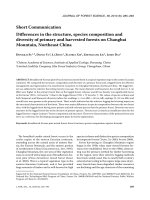Explain the different types, size and scope of organisations
Bạn đang xem bản rút gọn của tài liệu. Xem và tải ngay bản đầy đủ của tài liệu tại đây (858.22 KB, 20 trang )
<span class="text_page_counter">Trang 1</span><div class="page_container" data-page="1">
The author, an assistant analyst for a consulting organization in Vietnam, will write a report on VinFast-related business and business environment. There are 4 tasks and 4 primary topics in the report. The first goal is going to be to explain the ideas of various organizational kinds, scopes, and sizes. This section's material is studied primarily in light of the legal system and business environment in Vietnam. The second goal is to explain how departments within VinFast function, how they relate to the organizational structure, and how they collaborate. The third assignment requires the assistant to list and explain the positive and negative effects that the macro environment has on VinFast's operations using the PESTLE model. The fourth task write about the strategy of VinFast through marketing mix and highlight strengths and weaknesses, SWOT analysis.
<b>TASK 1. Explain the different types, size and scope of organisations</b>
1. Types and purposes of organization
A formal structure of connections, obligations, and powers known as an organization is used to accomplish particular goals. ‘A work organisation is a social arrangement for the controlled performance of collective goals’ (Buchanan and Huczynski, 2004). According to the definition, there are 3 main types of organizations: Profit organization, non-profit organization and non
government organization.
Each type of organization and how it differs from the others will be described in the four parts below (1.1–1.4).
1.1 Profit organization
Profit is the money that people, organizations, and enterprises keep after paying their bills and taxes to the government. Profit is something that every firm wants to achieve. A profit organization is any commercial entity whose main goal is to increase the owners' wealth through profits from everyday activities. Such institutions' profits may be invested in the company, set aside for future needs, or paid as dividends to shareholders. In a
</div><span class="text_page_counter">Trang 2</span><div class="page_container" data-page="2">conclusion, a P organization's primary goal is to make money so that it can continue to exist, grow, and serve its many users. This kind of organization has a very broad range of activities and is widespread around the world. Manufacturing, technology, and industry are examples of developing fields. Based on the aim and conditions of the organization, it may be divided into a number of different legal structures. It has positive social effects, such as raising people's standards of living and lowering unemployment, in addition to making a significant role in the national and global economies.
Some popular for-profit organizations in Viet Nam are: VTP investment Group, VNDIRECT Securities Corporation, VinFast
1.2 Non-profit organization (NPO)
The name of this organization also clearly shows their purpose, their purpose is not to make a profit. In fact, they still make a profit but their profits come from their sponsors and from the products they sell. Their remarkable point and difference are that what they earn is prioritized for society and provides benefits to the community. For the most part, donations to charities are tax free for the people and companies who make them, and the nonprofit organization itself does not have to pay taxes on the money it receives from donations or any other revenue it generates from fundraising operations.
In fact, the employees of this organization do not receive a salary, similar to volunteer work. Because the employees of this
organization work voluntarily and contribute to the community, their working time is not binding. On the other hand, for-profit organizations they must have a clear commitment to working time.
</div><span class="text_page_counter">Trang 3</span><div class="page_container" data-page="3">Some commonly known non-profit organizations in Viet Nam: Aiesec, SEAL-Net, VietAbroaderOrganization
1.3 Non-government organizations (NGO)
NGO is the abbreviation for Non-Governmental Organization, which refers to an association formed by citizens, which functions fully autonomously from the government to perform a wide range of human services and functions. religion. It is a non-profit entity; operates on a regional, national or international level depending on its reach and connectivity. It can be incorporated as a trust, society or a company. These organizations raise funds from governments, foundations, businesses, and people.
It performs a number of activities, to draw government attention to people's grievances, to support public policies, to promote political participation by providing information.
There are many NGOs that work for specific issues such as supporting human rights, women's and children's rights, environmental or health issues. International Committee of the Red Cross, Rotary International Conference, International Air Transport Association (IATA), International Chamber of Commerce (ICC), International Organization for Standardization (ISO) are some of the organizations well-known NGO operating worldwide. Some NGOs in Vietnam are: AIESEC, CARE International, UNICEF Việt Nam, SOS Children's Village,…
1.4 The differences between profit, non-profit and non-government organization The three types of organizations are summarized in the table below, along with a generalized comparison of their differences and similarities.
</div><span class="text_page_counter">Trang 4</span><div class="page_container" data-page="4">2. Micro, small, medium-sized enterprises (SMEs). Different business purposes, objectives and supply of goods and services.
As mentioned, not all business activities are aimed at making a profit. However, businesses don't have to be large global organizations with large workforces if their primary goal is to make a profit. They can be small, medium, large or even microscopic. The number of employees, the number of owners and/or
shareholders, their market share (i.e. their share of total market sales in the relevant sector) and their legal status are There are distinct differences between these different types of businesses.
The term "small to medium-sized enterprises" refers to a different class of companies (SMEs). The majority of businesses in the European Union fall under the category of SMEs. ‘‘The category of micro, small and medium-sized enterprises (SMEs) is made up of enterprises which employ fewer than 250 persons and which have an annual turnover not exceeding EUR 50 million, and/or an annual balance sheet total not exceeding EUR 43 million.’’ the European Commission states.
The number of employees and turnover are the primary determining variables for SMEs. The legal form of a company must be chosen since it will have a significant impact on how the company runs, raises money, and distributes earnings. A company may choose from a wide range of legal structures, but sole
</div><span class="text_page_counter">Trang 5</span><div class="page_container" data-page="5">proprietorship, partnerships, and private limited companies are the most popular among SMEs.
3. Legal structure
Government and the law both have authority over legal structures. Based on the different organizational and business structures, they are suitable for various company models and legal structures.
The author will explain several types of legal structures in the next three sections (2.1–2.3). Additionally, they should discuss their benefits, drawbacks, and actions in Vietnam in line with Vietnam Enterprise Law.
3.1 . sole proprietorship
Based on Vietnam Enterprise Law, A sole proprietorship is a company held by a single person who is exclusively liable for all of the company's assets and all business-related activities. In a sole proprietorship, one person is the only owner. There is no legal status for a sole proprietorship.
There are few advantages of sole proprietorship:
- A private company can be established quickly and without much difficulty due to its organizational structure, which is quite simple.
- If the proprietor wanted to shut down his business, it would be simple to do so. - The business's owner receives a direct payout of its profits.
On the other hands, it also has disadvantages:
- As they are the only owners of the company, they can find it challenging to get a loan from a bank; however, if they want to be approved, they must demonstrate a strong financial status. - The bank loan or obligation is unpaid, which puts the sole proprietorship in danger of bankruptcy.
- In the event of the owner's death, the sole proprietorship will also expire.
3.2. Partnership
</div><span class="text_page_counter">Trang 6</span><div class="page_container" data-page="6">A partnership is a business in which: There must be at least two general partners; capital contributors may also be general partners; General partners must be private individuals who are liable with all of their assets for the obligations of the company and who possess professional qualifications and a solid
professional reputation; Only the quantity of capital supplied to the company makes its contributors responsible for its debts. Partnerships are relatively self-sufficient. All members must approve on all actions. The liability is distributed according to the number of members, which benefits the business and reduces the financial strain. They can borrow more money from the bank due to the bigger number of members with authority than a sole proprietorship. However, there are certain disadvantages that come with that. A partnership, for instance, is not permitted to issue any securities in order to raise money in the public. When more charter capital is required, the firm will mobilize it by admitting new members, raising the capital contributions of each member, or documenting a rise in the asset worth of the
company. Additionally, due to this relationship, the entity runs the risk of dissolving if a partnership member passes away, loses the ability to engage in civil acts, or withdraws money from the business.
3.3. Private limited company
Small privately held businesses known as private limited companies, whose liability is constrained by shares, are common. The company can only have a small number of shareholders due to its tiny size and private ownership. In addition, private limited companies are unable to list their shares on the stock exchange because the shares cannot be openly traded. A minimum of one share must be issued at the moment of incorporation, but there is no other minimum capital requirement for private limited corporations in the UK ( Annie Jahangir, 2020). Many SMEs operate as private limited companies because it enables them to seek protection from personal liability, lower personal risk, and raise money through the selling of shares.
4. Size and scope of organizations
</div><span class="text_page_counter">Trang 7</span><div class="page_container" data-page="7">4.1. Micro, small, medium and large enterprises
Most of the enterprises are of medium, small to super small scale, while large enterprises account for a minority. Based on Decree 29/2018/ND-CP which was published by Vietnam government in 2018, it was divided into two groups based on their specific fields, which are: Group A (agriculture, forestry, aquaculture, industry, and construction), group B (trade and services).
Based on the size of the total capital (total capital equivalent to the total assets determined in the balance sheet of the enterprise) and the number of employees (the criterion of total capital is preferred). Decree No. 39/2018/ND-CP stipulates that small and medium enterprises are classified by size including micro enterprises, small enterprises and medium enterprises.
Large enterprises account for only 5% of the total number of registered enterprises today. However, large enterprises are important to the global economic growth of all nations. Creates a large volume of jobs and is responsible for boosting the economy.
</div><span class="text_page_counter">Trang 8</span><div class="page_container" data-page="8">Creating important industries and services: today large
enterprises operate in key industries in each country's economy. In Vietnam, those are enterprises such as oil and gas
corporations, electricity corporations, coal and mineral corporations. (Legal advice, 2022)
4.2. Franchising, joint ventures and licensing, international, multinational
4.2.1. Franchising
According to Vietnam Commercial Law (2005), franchising is a business transaction in which the franchisor permits and demands that the franchise business buy, sell, and offer services in
accordance with the following conditions: The buying and selling of goods, as well as the services offered, are strictly governed by the franchisor's system of business organization and are in line with the franchisor's trademarks, trade names, business secrets, slogans and symbols, business and advertising images; the franchisor has the right to control and aid the franchisee in managing the business.
4.2.2. Joint ventures
An organization can share ownership of a commercial partner through a joint venture. A joint venture is a unique firm created and simultaneously owned by at least two separate independent legal entities to realize shared business objectives.
4.2.3. Licensing
Licensing is a business model in which the licensor grants the right to use the company's intellectual property, trademarks, or production of products to the licensee, in return for royalties. The licensed company then makes a huge capital investment to start operations. (Legal advice, 2022)
4.2.4. International
</div><span class="text_page_counter">Trang 9</span><div class="page_container" data-page="9">International businesses are those that import and export raw materials, or sell products or services to other nations, but make no other investments there.
4.2.5. Multinational
A multinational company is a type of business with subsidiaries around the world. According to the generally accepted definition, a firm or business that derives at least 25% of its annual revenue from sources outside of its nation of origin. Establishing
multinational corporations within their own borders is also advocated for developing countries, especially new industrialized countries (NICs).
<b>TASK 2. The interrelationship of the various functions within VinFast (VinFast LLC) and how they link to organisational structure</b>
<b>1.VinFast overview</b>
VinFast is a startup in the automotive field with the backing of VINGROUP - the largest private enterprise in Vietnam. Right from the start, the brand's goal is to be able to create world-class products with Vietnamese identity. This is a Vietnamese car manufacturer that was formed in 2017.
2. The role of departments within VinFast
</div><span class="text_page_counter">Trang 10</span><div class="page_container" data-page="10">2.1. General Administration department
Administration is the process of managing an organization. It can be defined as a system for controlling the operations of a company, institution, or society. General administration who manage smaller divisions such as: Marketing, Human Resources, Accounting and Finance, etc.. The role of administration within Vinfast is to ensure that the company runs smoothly and efficiently.
2.2. Marketing department
Vinfast is a Vietnamese automobile company. It is the first car company in Vietnam to have a joint venture with Toyota Motor Corporation. Vinfast was established in 2016 by a joint venture between Toyota Motor Corporation and Vingroup, one of the largest conglomerates in Vietnam. Vinfast has been selling cars since December 2017 and has received over 1,000 orders for the 2018 model year.
The marketing team at Vinfast’s primary focus is on building awareness of their brand. They do this by implementing an extensive social media campaign and using traditional marketing channels such as print ads, billboards, TV commercials and more to get their name out there.
2.3. Human Resources
<small>General administration</small>
<small>MarketingHuman ResourcesAccounting and Finance</small>
</div>








